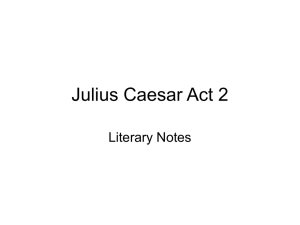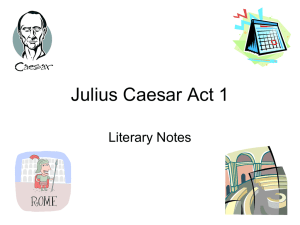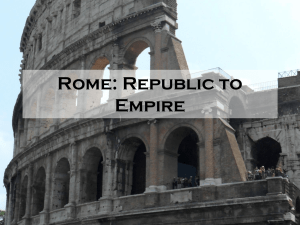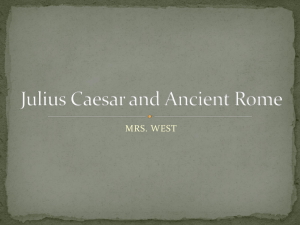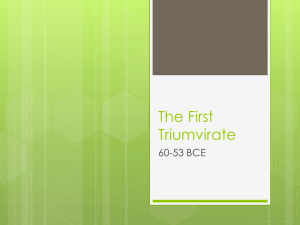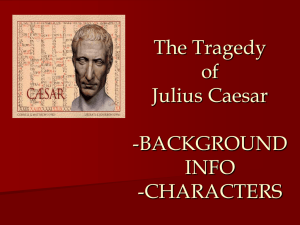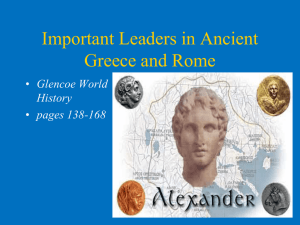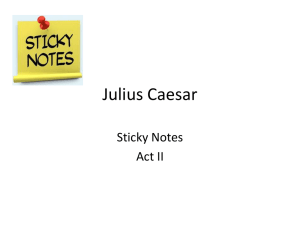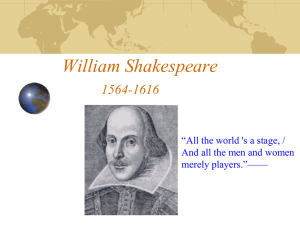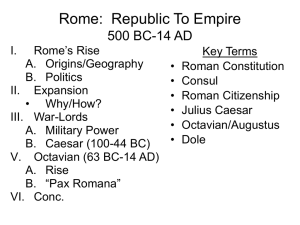Julius Caesar - Illini Central
advertisement
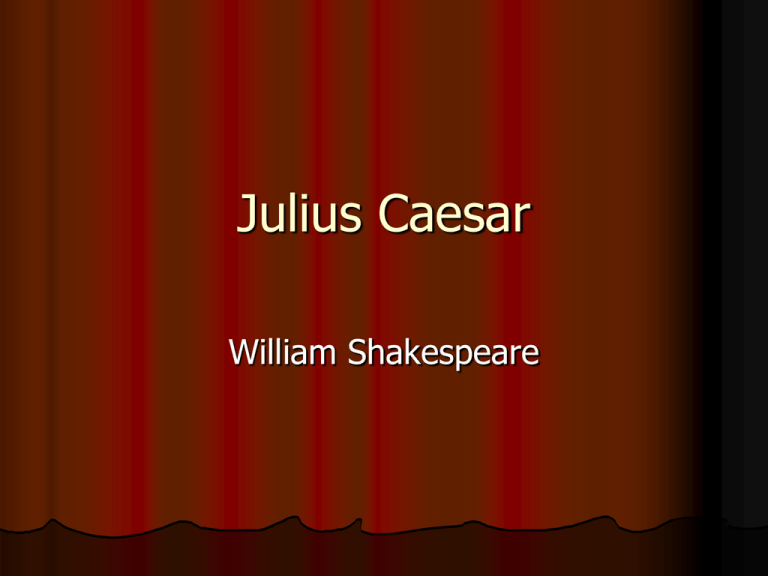
Julius Caesar William Shakespeare Julius Caesar Unit Essential Questions What are the qualities and responsibilities of a good leader? What are the key factors in determining the success or failure of a leader? How does a leader affect a group or society? When should we follow the guidance of others and when should we follow our own conscience? How does a person make ethical choices? What makes a person persuasive? Pre Reading Notes Genres of plays Structure of plays Background (historical Julius Caesar) Act I, Scene I questions Play Genres Tragedy Comedy History Tragedy The fall of a great man or family Not because of a character flaw, but because of a choice he made Many people die Comedies Not simply comical in the modern sense, but often tensions between traditional roles (male vs. female, poor vs. rich, old vs. young, etc). Usually end in marriage, revision or restoration of traditional roles. (A Midsummer Night’s Dream, Much Ado About Nothing, etc) Histories Based on the lives of English kings. (Henry IV, Henry V, Richard III, etc) Shakespeare Play Structure Act 1 -- Exposition. We meet the characters, and time and place are established. We learn about the antecedents of the story. Attention is directed toward the conflict and dramatic tensions. Act 2 – Rising Action/Complications. The course of action becomes more complicated.Tension mounts, conflicts arise and momentum builds up. Act 3 -- The Climax of Action. The development of conflict reaches its high point, the Hero stands at the crossroads, leading to victory or defeat, crashing or soaring. Play Structure Act 4 -- Falling Action. The consequences of Act 3 play out, momentum slows. If it's a tragedy, it looks like the Hero can be saved. If not, then it looks like all may be lost. Act 5 – Resolution/Catastrophe. The conflict is resolved, whether through a catastrophe, the downfall of the hero, or through his victory and change. Background For centuries, Romans debated and even fought civil wars while trying to decide whether a monarchy, a republic or a dictatorship was the best form of government. Until 509 B.C., Rome was a monarchy, but, in that year, the Brutus family evicted Trarquinius Superbus from the throne and Rome was established as a republic. Background By 100 B.C., Rome was a moderate democracy in form; in actual practice, the Senate was ruling Rome. In 60 B.C., a triumvirate (a 3-man rule) of Caesar, Crassus, and Pompey was formed to govern Rome. In 58 B.C., Caesar was made governor of part of Gaul, and at the age of 44 began his military career. During the next ten years, he proceeded to conquer all of Gaul. Gaul (Western Europe) Background After Crassus was killed in battle, trouble began to develop between Pompey and Caesar. Pompey, jealous of Caesar’s popularity, persuaded the Senate to order Caesar to disband his army and return to Rome. But Caesar invaded Rome and made himself absolute ruler of Rome. Meanwhile, Pompey fled to Greece. Caesar defeated Pompey’s army and Pompey fled to Egypt where he was later murdered. Background Three years after Caesar defeated Pompey’s army, Caesar defeated Pompey’s two sons. Thus, as Shakespeare begins his play with Caesar returning in victory from Spain, Caesar was the undisputed leader and master of the entire Roman world. Roman World Ruled by Caesar Background Setting: Rome, Italy, part of the continent of Europe, and it is situated along the Tiber River. There were two classes of people in Rome. The rich were called Patricians. The poor were called Plebeians. Background Hero: Unlike Romeo and Juliet where the title characters were the heroes of the play, Julius Caesar is not the hero. The hero in this play is Brutus, a noble man who truly believes his actions are for the good of his country. Brutus dominated much of the play. Background Timeline: Shakespeare compresses the actual historical time of 3 years into a period of 6 days. (See handout.) Characters: See handout Act I, Scene I Questions: After we read Act I, Scene I aloud in class, answer the following questions in your notes: 1.) Who is in this scene? 2.) What are they doing? 3.) Where does the scene take place? 4.) When does the scene take place (and why is it important)? 5.) Why are the people celebrating? 6.) How do Marullus and Flavius feel? Rhetoric and Persuasion Rhetoric—the art of speaking or writing effectively According to Aristotle, rhetoric is “the ability, in each particular case, to see the available means of persuasion.” Three types Ethos Logos Pathos Rhetoric and Persuasion Ethos Appeal based on the character of the speaker Relies on the reputation of the speaker/author as credible, trustworthy, honest, and ethical Uses the following: Language appropriate to the audience Restrained, sincere, fair-minded presentation Appropriate level of vocabulary Correct grammar Rhetoric and Persuasion Logos Appeal based on facts, evidence, and reason Appealing to the audience’s sense of what is logical Uses the following: Definitions Factual data and statistics Quotations Citations from experts and authorities Informed opinions Rhetoric and Persuasion Pathos Appeal based on feelings emotions Uses: Vivid, concrete language Emotional examples Vivid descriptions Narratives of emotional events Emotional tone Figurative language Persuasion in Advertising Example 1: Logos Tire Ad #1: Tire X lasts 40% longer than the leading brand, costs half the price, and has achieved excellent anti-hydroplaning ratings. Persuasion in Advertising Example 2: Ethos Tire Ad #2: Jeff Gordon, successful racecar driver and tire aficionado prefers Tire X. Persuasion in Advertising Example 3: Pathos Assignment In groups of three, find a minimum of 4 magazine advertisements. Complete the following for each advertisement: Write a detailed description of the ad (who is in it, what is going on, what it is advertising, etc) Explain which persuasive device the ad is appealing to (logos, ethos, pathos) and why you believe it is that particular device. Decide if you think the ad company was successful in persuading you to buy the product, donate to something, vote a certain way, etc. Choose 1 advertisement to present to the class. Be sure to show us the actual advertisement, explain the persuasive device, any fallacies, and if you thought the ad was successful. Act I, Scene 2 All about Cassius Mean Girls clip: http://www.youtube.com/watch?v=GPDt6cMYvoM Soliloquy 1. A soliloquy is when a character of a drama/play conveys his/her secret thoughts and/or intentions to the audience or the readers. 2. While doing so, he/she preserves the secrecy of those thoughts/intentions from other characters of the drama. It’s just the character and the reader. 3. It helps the audience/reader to better understand the character, his thoughts, his intentions, and the presumable development of the play. Act I, Scene 2 All about Cassius As we read, think about the elements of persuasion that Cassius uses to manipulate Brutus What information do we gain from his soliloquy? ‘Open Mind’ graphic organizer—List Cassius’s thoughts throughout Act I, Scene 2. What is his plan? ACT III, Scene 2 Funeral Speeches Terms to Know Prose—the ordinary language people use when writing or speaking; not poetic Poetry—Literary work in which special intensity is given to the expression of feelings and ideas by the use of distinctive style and rhythm Rhetorical questions—a figure of speech in the form of a question without the expectation of a reply Sarcasm—The use of irony to mock or convey contempt Repetition—repeating words, lines, or phrases Ethos, logos, pathos—appeal to character, logic, emotion Funeral Speeches For each of the terms defined on the previous page, write an example from Antony’s speeches in Act III, Scene 2 on your note sheet. HW: Antony writing prompt
